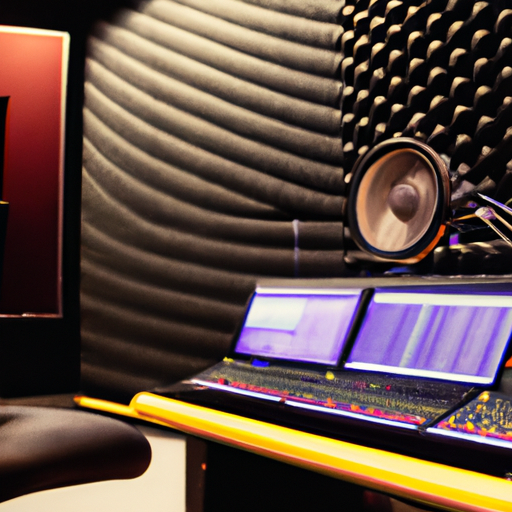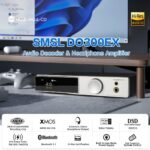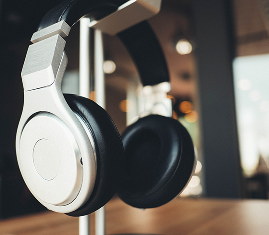Imagine you’re sitting in a recording studio, carefully adjusting the sound on your monitors. With each tweak of the knobs, you aim for the perfect balance of bass, midrange, and treble. But what if I told you that the accuracy of your studio monitoring could be greatly influenced by the very room you’re in? It’s true; room acoustics play a significant role in how accurately you hear sound through your monitors. In this article, we’ll explore the fascinating connection between room acoustics and studio monitoring accuracy, and discover why it’s crucial to consider the environment when working in a recording studio.
Understanding Acoustics
Definition of Acoustics
Acoustics is the branch of physics that deals with the study of sound and how it behaves in various environments. It explores the generation, transmission, and reception of sound waves and how they interact with different materials and spaces. In the context of music production and sound engineering, understanding acoustics is essential for creating an optimal listening environment and ensuring accurate monitoring of audio.
Sound Waves and Reflection
Sound waves are vibrations that travel through different mediums, such as air, water, or solid objects. When sound waves encounter a surface, they can be reflected, absorbed, or transmitted. Reflection occurs when sound waves bounce off of surfaces and change direction, which can result in echoes or reverberation. The nature of the reflective surfaces and the shape of the room can significantly impact how sound waves behave and how they are perceived by the listener.
Importance of Acoustics in Sound Engineering
Acoustics play a crucial role in sound engineering and music production. The accuracy of studio monitoring is highly dependent on the acoustics of the room. Every decision made during the recording, mixing, and mastering process relies on what is heard through the studio monitors. If the room acoustics are not properly optimized, the monitoring environment can introduce distortions, colorations, and inaccuracies in the audio playback. Therefore, understanding and addressing room acoustics is essential for achieving accurate sound reproduction.
Studio Setup and Acoustics
Fundamental Components of a Sound Studio
A sound studio consists of various components, each serving a specific purpose in the recording and production process. These components typically include recording equipment (microphones, audio interfaces, etc.), studio monitors, soundproofing materials, acoustic treatments, and furniture. The overall layout, placement, and positioning of these components are essential for creating an optimized studio environment that minimizes unwanted reflections and ensures accurate monitoring.
Relationship between Studio Setup and Acoustics
The studio setup and room acoustics are intertwined and have a direct impact on each other. A well-designed studio setup takes into consideration the principles of acoustics to minimize unwanted reflections and resonances. The placement of studio monitors, for example, should consider the listening position, the room dimensions, and the reflective surfaces to optimize the soundstage and imaging. Similarly, the placement of acoustic treatments and soundproofing materials should be strategically planned to control the room’s acoustic properties effectively.
Challenges of Poor Studio Setup
A poor studio setup can result in numerous challenges that hinder accurate monitoring and sound production. These challenges include:
-
Frequency imbalances: Improper speaker placement and room interactions can cause uneven frequency response, leading to inaccurate monitoring and mixing decisions.
-
Comb filtering: Comb filtering occurs when sound waves interact with reflections and cancellations, resulting in notches and peaks in the frequency response. This can lead to coloration and masking of certain frequencies, making it difficult to accurately judge the audio balance.
-
Standing waves: Standing waves are resonant frequencies that can be created in enclosed spaces, causing certain frequencies to be emphasized or canceled out. This can result in inaccurate bass response and uneven listening experiences.
-
Flutter echoes: Flutter echoes are rapid, repetitive reflections that can occur between parallel surfaces. They can cause smearing and blurring of sound, affecting the perceived clarity and imaging of audio playback.
By addressing these challenges through proper studio setup and acoustic treatment, the accuracy of studio monitoring can be significantly improved.
Role of Room Acoustics in Studio Monitoring
Concept of Studio Monitoring
Studio monitoring refers to the process of accurately reproducing and evaluating audio in a recording or mixing environment. It involves using specialized speakers, known as studio monitors, to play back recorded material and assess its quality and balance. The goal is to have a monitoring setup that faithfully represents the recorded audio, allowing sound engineers to make informed decisions during the mixing and mastering process.
How Room Acoustics Impact Studio Monitoring
The acoustics of the room have a substantial impact on studio monitoring accuracy. The interaction between sound waves and the room’s reflective surfaces and dimensions can affect the frequency response, transient response, stereo imaging, and overall tonal balance perceived by the listener. Room reflections and resonances can color the sound, introduce phase cancellations, and mask certain frequencies, leading to inaccurate monitoring and potentially misleading mix decisions.
Examples of Good Acoustics Positive Influence on Studio Monitoring
When the acoustics of a studio are well-designed, the benefits to studio monitoring accuracy become apparent. With optimal room acoustics, studio monitoring can provide the following benefits:
-
Balanced frequency response: Properly treated and designed rooms can ensure a more even frequency response, allowing the listener to accurately hear the full spectrum of the audio being reproduced.
-
Accurate transient response: The room’s acoustic characteristics can impact how quickly sound waves decay and settle, affecting the ability to hear precise details and transients in the audio playback.
-
Clear stereo imaging: Good room acoustics can enhance the perceived width, depth, and localization of sound sources, providing a more accurate representation of the stereo field.
-
Unbiased tonal balance: When room modes and resonances are effectively controlled, the tonal balance of the audio playback remains consistent throughout different positions within the room, enabling reliable mixing decisions.
By creating an environment with good room acoustics, sound engineers can rely on their monitoring setup to accurately reproduce and evaluate audio, leading to better mixes and productions.
Types of Studio Monitors
Near-Field Monitors
Near-field monitors are small, accurate speakers designed for close listening distances. They are typically placed in close proximity to the listener, at ear level, and angled towards the listening position. Near-field monitors provide a detailed and focused sound, minimizing the influence of room acoustics on the audio playback. They are commonly used in professional recording and mixing studios, where accurate monitoring and critical listening are essential.
Mid-Field Monitors
Mid-field monitors are larger speakers designed for medium listening distances. They are positioned a few feet away from the listener and are capable of producing higher sound pressure levels compared to near-field monitors. Mid-field monitors strike a balance between accuracy and direct sound, allowing for better representation of low-frequency content. They are often used in larger control rooms and studios where a more powerful monitoring system is required.
Far-Field Monitors
Far-field monitors, also known as main monitors or mains, are large speakers designed for long listening distances. They are placed at a considerable distance from the listener and are capable of producing high sound pressure levels with extended bass response. Far-field monitors are typically used in larger control rooms and mastering facilities, where precise monitoring at longer distances is necessary. They provide a wide sweet spot and are designed to reproduce audio accurately in a variety of listening positions.
How Monitor Type Influences Room Acoustics
The choice of monitor type can have a significant influence on the room acoustics and the overall sound quality experienced in the listening environment. Near-field monitors, due to their close proximity to the listener, minimize the influence of room reflections and resonances, making them less susceptible to the room’s acoustic properties. Mid-field and far-field monitors, on the other hand, are more affected by room interactions, as they are positioned at greater distances from the listener. The size, placement, and characteristics of the monitors should be carefully considered in relation to the room acoustics to achieve optimal monitoring accuracy.
Common Acoustic Problems in Studios
Bass Buildup
One of the most common acoustic problems in studios is bass buildup, which occurs when low-frequency energy accumulates and becomes exaggerated in certain areas of the room. This can lead to an uneven bass response, where certain frequencies are noticeably louder or quieter than others. Bass buildup can be caused by room resonances and standing waves, and it can severely impact the accuracy of monitoring, especially when working on bass-heavy music genres.
Flutter Echoes
Flutter echoes are rapid and repetitive reflections that occur between parallel surfaces in a room. They are characterized by a distinct “fluttering” sound and can cause smearing and blurring of audio. Flutter echoes can be perceived as a lack of clarity and can affect the accuracy of critical listening and sound localization. Flutter echoes can be mitigated by introducing irregularities in the room surfaces, such as diffusers, or by adjusting the room dimensions and distances between parallel walls.
Sound Leakage
Sound leakage refers to the unwanted transmission of sound between different spaces. In a studio environment, sound leakage can occur between recording rooms, control rooms, or other adjacent areas. This can result in undesirable bleed and can compromise the accuracy of monitoring, especially in recording situations where isolation and separation are crucial. Proper soundproofing measures, including the use of isolation booths and acoustic seals, should be implemented to minimize sound leakage.
Standing Waves
Standing waves are resonant frequencies that occur in enclosed spaces, such as a studio room. They are caused by sound waves reflecting off parallel surfaces and interfering constructively or destructively with each other at specific frequencies. Standing waves can result in frequency peaks and nulls, where certain frequencies are exaggerated or canceled out. This can lead to an uneven tonal balance and inaccurate monitoring. Bass traps and strategic speaker and listener placement can help mitigate the effects of standing waves.
How these Problems Affect Monitor Accuracy
These common acoustic problems in studios can have a significant impact on monitor accuracy. Bass buildup can cause uneven bass response, leading to inaccurate low-frequency monitoring and mixing decisions. Flutter echoes can mask certain frequencies and blur the transient response, affecting the perceived clarity and detail of audio playback. Sound leakage can introduce unwanted bleed, compromising the ability to isolate and accurately monitor individual tracks. Standing waves can cause irregular frequency response and tonal imbalances, making it challenging to accurately judge the overall mix.
Addressing these acoustic problems through proper treatment and room design is crucial for maintaining accurate monitor accuracy and ensuring reliable sound production.
Methods to Improve Room Acoustics
Sound Absorption
Sound absorption is the process of reducing the reflection of sound waves by converting acoustic energy into heat or other forms of energy. Sound-absorbing materials, such as foam panels, acoustic panels, and bass traps, are strategically placed in a room to absorb excessive reflections and control reverberation time. Sound absorption helps reduce flutter echoes, comb filtering, and unwanted reflections, resulting in a more accurate and controlled listening environment.
Sound Diffusion
Sound diffusion involves scattering sound waves in different directions to create a more even distribution of energy within a room. Diffusers are specialized acoustic panels or structures that scatter incoming sound waves, reducing their coherence and preventing the buildup of standing waves and flutter echoes. By introducing diffusers in key positions, one can achieve a more balanced sound diffusion and eliminate the negative effects of concentrated reflections, thus improving monitor accuracy.
Bass Trapping
Bass trapping specifically targets the control of low-frequency energy, which tends to accumulate in corners and along walls due to room resonances. Bass traps are designed to absorb or dissipate low-frequency sound waves, reducing excessive bass buildup and standing waves. By strategically placing bass traps in the corners and areas of the room with the most significant low-frequency energy, bass trapping can help achieve a flatter and more accurate bass response.
Room Tuning
Room tuning involves the optimization and fine-tuning of a room’s acoustic properties to achieve a more balanced frequency response and overall sound quality. This can be done through parametric equalization, where specific problematic frequencies are carefully boosted or attenuated to achieve a more accurate and desired sound. Room tuning also takes into account the placement and positioning of speakers and listeners, as well as the impact of room dimensions and surfaces on the overall acoustics.
Using Acoustically Transparent Materials
Acoustically transparent materials are specially designed surfaces or fabrics that allow sound to pass through while providing absorption or diffusion properties. These materials can be used to cover reflective surfaces, such as walls and ceilings, to minimize the negative effects of reflections and resonances. Acoustically transparent materials help improve monitor accuracy by reducing reflections and providing a more neutral and controlled listening environment.
By combining these methods, studio owners and sound engineers can significantly improve the room acoustics, resulting in more accurate monitoring and better sound production.
Acoustic Treatment VS Room Tuning
Definition of Acoustic Treatment and Room Tuning
Acoustic treatment refers to the process of modifying a room’s acoustic properties through the use of sound-absorbing materials, diffusers, and bass traps, among other techniques. The aim of acoustic treatment is to control reflections, reduce resonances, and create a more balanced and controlled listening environment.
Room tuning, on the other hand, involves the optimization and adjustment of a room’s acoustic characteristics through the use of equalization and other audio processing techniques. Room tuning aims to achieve a desired frequency response and sound quality by compensating for the room’s inherent weaknesses or resonant frequencies.
Key Differences and Similarities
While both acoustic treatment and room tuning aim to improve the acoustics of a room, they differ in their approaches and goals. Acoustic treatment primarily focuses on physical modifications to control reflections and resonances, creating a more acoustically neutral environment. Room tuning, however, focuses on using audio processing tools to electronically alter the frequency response and compensate for the room’s characteristics.
Despite these differences, both acoustic treatment and room tuning can be used together to achieve optimal monitoring accuracy and sound quality. Acoustic treatment sets the foundation by eliminating or reducing acoustic problems, while room tuning fine-tunes the response to achieve the desired sonic characteristics.
Situations for Use
Acoustic treatment and room tuning are both important considerations in any studio or listening environment. Acoustic treatment is particularly crucial when dealing with significant acoustic problems, such as excessive reflections, bass buildup, or flutter echoes. It provides a solid starting point for achieving accurate monitoring by addressing the physical aspects of the room’s acoustics.
Room tuning, on the other hand, can be used to fine-tune the response of a room and compensate for any remaining weaknesses or imbalances. It is particularly useful when dealing with small or irregularly shaped rooms that may have inherent acoustic issues. Room tuning can correct the frequency response and optimize the sound quality based on the desired listening preferences or industry standards.
Overall, a combination of both acoustic treatment and room tuning is often necessary to achieve the best possible monitoring accuracy and sound reproduction.
Measurement of Acoustic Parameters
Importance of Measuring Acoustics
Measuring acoustic parameters is crucial for understanding and evaluating the acoustic characteristics of a room. By taking objective measurements, sound engineers and acousticians can quantify various aspects of the room’s acoustics and identify specific problem areas that may be affecting monitoring accuracy. Measurements provide valuable data that can inform decisions regarding acoustic treatment, room tuning, and overall room design.
Key Acoustic Parameters to Measure
Several key acoustic parameters are commonly measured to assess the performance of a room’s acoustics. These parameters include:
-
Reverberation Time (RT60): Reverberation time is the duration it takes for sound to decay by 60 decibels after the sound source has stopped. It provides information about the room’s decay characteristics and can help determine the amount of sound absorption required to achieve a desired reverberation time for a given application.
-
Frequency Response: The frequency response measures the variation in sound level across the audible spectrum. It indicates how accurately the room reproduces different frequencies and helps identify tonal imbalances or resonant peaks and nulls.
-
Early Reflections: Early reflections are the first reflections of sound waves that reach the listener directly after the direct sound. Measuring and analyzing early reflections can provide insights into the room’s spatial characteristics, the location of reflective surfaces, and potential comb filtering issues.
-
Sound Pressure Level (SPL): Sound pressure level measures the loudness of sound in a specific location within a room. By measuring SPL at different positions, sound engineers can assess the consistency of volume across the listening area and identify loudness variations that may affect accurate monitoring.
Tools Used for Measurement
Various tools and equipment are used to measure acoustic parameters accurately. These tools typically include:
-
Sound Level Meters: Sound level meters measure the sound pressure level in a room and provide data on the loudness of sound at different frequencies. They are essential for assessing the overall sound pressure levels and identifying deviations in volume across the listening area.
-
Impulse Response Measurement Systems: Impulse response measurement systems generate short-duration test signals and measure the time it takes for the signal to travel from the source to a microphone. This allows for the calculation of parameters such as reverberation time and early reflections.
-
FFT Analyzers: FFT (Fast Fourier Transform) analyzers are used to analyze the frequency content of a signal. They provide detailed information about the distribution of energy across the audible spectrum, enabling a comprehensive assessment of the room’s frequency response.
-
Test Tone Generators: Test tone generators produce pure tones at specific frequencies, which can be used to measure the room’s response to individual frequencies. They are helpful in identifying resonances, nulls, or other irregularities in the frequency response.
Interpreting Measurement Results
Interpreting measurement results involves analyzing the data collected and identifying patterns or anomalies that may impact monitoring accuracy. Deviations from desired acoustic parameters can guide decision-making regarding acoustic treatment, room tuning, and optimal speaker and listener placement.
For example, if the measurement reveals excessive reverberation times, additional sound absorption materials may be required to reduce the decay time and improve clarity. If the frequency response exhibits peaks or nulls, parametric equalization may be used during room tuning to compensate for these irregularities and achieve a more balanced response.
Measurement results provide valuable insights into the room’s acoustics and serve as a reference point for making informed decisions to optimize monitor accuracy and sound quality.
Influence of Room Size and Shape on Studio Acoustics
Role of Room Size in Acoustics
The size of a room plays a significant role in its acoustic properties. Different room sizes can have varying effects on the sound waves, resonances, and reflections in the space. Small rooms tend to have stronger standing waves and resonances due to the limited space for sound to propagate. This can result in more pronounced bass buildup and irregular frequency response. Larger rooms, on the other hand, can exhibit smoother frequency responses and reduced room modes due to the increased distance for sound waves to travel.
The size of a room should be carefully considered when designing a studio or listening environment to ensure optimal monitor accuracy and sound reproduction.
Role of Room Shape in Acoustics
The shape of a room also influences its acoustic characteristics. Rooms with parallel walls, such as rectangular or square-shaped rooms, can create strong standing waves and flutter echoes due to the continuous reflections between parallel surfaces. This can result in irregular frequency response and problematic resonances at specific frequencies.
Non-parallel or irregularly shaped rooms, on the other hand, can help disperse sound waves and reduce the concentration of reflections. This can result in a more diffused sound field, improved stereo imaging, and reduced flutter echoes. Irregularly shaped rooms often require more strategic placement of studio monitors, listeners, and acoustic treatments to ensure optimal monitoring accuracy.
Optimal Room Sizes and Shapes for Good Acoustics
While there is no one-size-fits-all solution for room sizes and shapes in studio acoustics, certain guidelines can help achieve better monitoring accuracy and sound quality. In general, larger rooms with sufficient dimensions are preferable, as they provide more room for sound waves to propagate and reduce the impact of resonances and standing waves.
As for room shape, non-parallel walls and irregular shapes can help diffuse reflections and reduce the negative effects of flutter echoes and standing waves. Angled or curved surfaces can help disperse sound energy and create a more spacious and balanced sound field.
When designing a studio or listening room, it is essential to carefully consider both the size and shape of the room to achieve the best possible acoustics for accurate monitoring and sound reproduction.
Case Studies of Studio Acoustic Design
Review of Studies on Acoustic Design
Numerous case studies have been conducted to evaluate the impact of different acoustic design approaches on studio monitoring accuracy. These studies often involve the measurement and analysis of various acoustic parameters, subjective listening tests, and comparisons of different room treatments and configurations.
One such study focused on the effects of different diffusion schemes on perceived sound quality and imaging in control rooms. The results showed improvements in localization and spaciousness when diffusers were strategically placed along reflective surfaces.
Another study investigated the impact of varying room sizes on bass response and frequency balance. It concluded that larger rooms with balanced room modes and proper acoustic treatment resulted in more accurate bass reproduction and overall tonal balance.
Interpretation of Findings
The findings from various case studies emphasize the importance of addressing room acoustics in achieving accurate monitoring. Optimizing the room’s acoustics through acoustic treatment, soundproofing, and strategic speaker and listener placement can significantly improve monitoring accuracy and sound reproduction.
The studies also highlight the benefits of diffusion and diffusion schemes in controlling reflections, improving imaging, and enhancing the overall perceived sound quality. Diffusers can help address flutter echoes and standing waves while providing a more diffuse sound field and accurate stereo imaging.
Furthermore, the case studies emphasize that room size and shape play critical roles in studio acoustics. Larger rooms with balanced dimensions tend to exhibit better bass response and less pronounced room modes, resulting in improved monitoring accuracy. Non-parallel walls and irregularly shaped rooms can help minimize the negative effects of reflections and resonances, leading to a more neutral listening environment.
Implementation of Findings in Real-World Studios
The findings from these case studies and research efforts have been applied in real-world studio designs and acoustic treatments. Many professional studios and listening spaces have incorporated diffusion panels, bass traps, and sound-absorbing materials to create more accurate monitoring environments.
Notable studios around the world have invested in room design and acoustic treatment to achieve optimal monitor accuracy. By implementing the principles and recommendations derived from case studies and research, these studios have been able to create listening environments that provide accurate and reliable sound reproduction.
These real-world examples validate the importance of considering room acoustics and implementing proper treatment methods to achieve accurate studio monitoring and sound production.
In conclusion, understanding the influence of room acoustics on studio monitoring accuracy is crucial for sound engineers, producers, and anyone involved in music production. By addressing the acoustics of the studio environment, considering room size and shape, and implementing appropriate acoustic treatments, accurate monitoring can be achieved. This, in turn, leads to better mixing decisions, improved sound quality, and enhanced overall music production.










